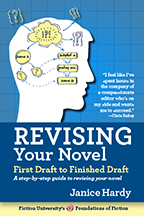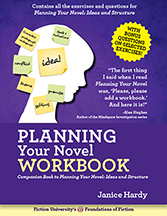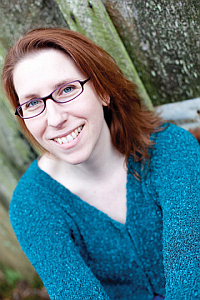Backstory: Finding the Right Balance — Guest: Janice Hardy

When it comes to writing, we often have to find the right balance of elements. We’ve talked before about finding the right balance for our story’s descriptions, our characters’ emotions, and even real-world references.
Too much of an element can slow down our story’s pace, undercut tension, or create a feeling of melodrama. Too little of an element can leave readers confused or unconnected to the story and characters.
Today, I’m excited to welcome back Janice Hardy for another entry in her short series of monthly posts here. Last time, she shared her advice for planning the end of a story to figure out its plot.
This month’s post focuses on revision, specifically the element of backstory for our characters. Too much backstory slows the pace, can feel irrelevant, and lead to repetition. Too little backstory can leave readers in the dark about characters’ motivations.
She’s sharing her two-step process for how to make the backstory less likely to slow our story’s pace, as well as tips for how to hide backstory and when to know we need more. Please welcome Janice Hardy! *smile*
*****
How to Balance Your Backstory During Revisions
Everybody has a backstory. In fiction though, that past isn’t always relevant, even if it is interesting.
Readers like to see a story moving, and stopping to explain a character’s history tends to bog the narrative down. Too much backstory is high on the list of why agents reject a manuscript, and many advise to cut all backstory from the first fifty pages. This is why it’s critical to find the right backstory balance.
Step One: Eliminate Unnecessary Backstory
Once you’ve identified any unnecessary backstory in a scene, you have three choices:
- cut it
- move it to where it is relevant
- make it relevant in that scene
Your protagonist’s character arc can indicate which aspects of the character’s personality are the most relevant, and guide you in gauging the right backstory needed.
If you’re unsure if the backstory is unnecessary or not, consider:
- How Does It Affect the Scene’s Goal?
Backstory that affects motivation feels natural because it has a place in the story. It matters to the character and to the things readers care about. If the backstory has no bearing on what the protagonist is trying to do in that scene (either directly or by affecting a decision made in that scene) then it’s probably not needed.
- Were Any of the Scene’s Characters Involved in the Backstory?
If the backstory changes the way readers (or even characters) see the scene, it might be worth keeping. Unless of course, that change steals tension or reveals a secret better left a mystery.
- How Does the Point-of-View Character Feel about the Backstory?
People think about the past when it has relevance on the present. If the point-of-view character doesn’t care, or isn’t affected by the backstory, there’s no need to reveal it.
Step Two: Revise Backstory to Show, Not Tell
Take a look at any remaining backstory and ask: is it showing or telling the information? Backstory is a common place for told prose to sneak in as you explain the history and why it matters to the character at that time.
Look for common telling words, such as “in order to” or “because” or “which” or “”once” to help spot backstory. If it feels like you’re stopping the story to explain something, odds are it’s telling, not showing.
Ways to Hide the Backstory
If you have backstory that needs to be there, try slipping it into the text in small bites, or disguise it as something else.
Background the Backstory:
Hiding the backstory in plain sight is a handy trick to get the information into the story without stopping the story to explain it.
For example, if you wanted to tell readers about the terrible past of your protagonist, and that she spent nine years in an underground prison, think of the things that might have affected her because of that experience. How might that change her behavior in the scene? Is she extra sensitive to the light? Claustrophobic? Very good at getting around when she can’t see well?
By putting your backstory in the background (backgrounding), you can flesh out your characters and show their history without stopping the story to explain it. Better still, you’ll leave enough tantalizing hints that readers eventually want to know the whole story.
Drop Teasing Hints:
Instead of revealing all of a character’s past, try dropping hints here and there to tease readers so they want to know the history. Look for places to toss off a casual comment or exhibit an interesting skill that’s never explained. After a while, readers will be so intrigued they’ll have no problem with the story pausing while this history is explained in more depth.
Be wary of being too vague with hints and clues. Find the right balance between a tease and being too cryptic to be understood, which can turn readers off and confuse them. Make readers think, “Ooo, what’s that all about?” not “What the heck are they talking about?”
If You Need More Backstory, Not Less
There are rare instances when a novel actually needs more backstory, so if analyzing your backstory reveals certain scenes require additional information to fully understand them, go ahead and flesh out those details. Just make sure what’s being added is truly necessary.
Red flags that a scene needs more backstory include:
- Readers Are Having a Hard Time Understanding the Importance of the Scene.
If your beta readers or critique partners aren’t catching the significance of a scene, or don’t know why something matters, you might need a little backstory to explain the motives or significance.
- The Critical Information Has Never Been Discussed or Shown.
While most of a character’s past can be shown in how she interacts with the world, sometimes the only way to convey that information is by hearing the backstory of that character.
- The Backstory Is Complicated.
In genre novels with a lot of world building, it’s more common to see an above-average amount of backstory. It’s much harder to glean clues from how a character acts when the world isn’t a world readers are familiar with.
Backstory isn’t just explaining the characters’ history, it’s about showing the experiences that shaped their lives and made them act the way they do. Backstory affecting motivation feels natural because it has a place in the story. It matters to the character and to the things readers care about.
You want to mention the things that are driving characters to act, not just things that happened in their pasts. Pick what’s important both to the character and to the story itself.
*****
Win a 10-Page Critique From Janice Hardy
Three Books. Three Months. Three Chances to Win.
 To celebrate the release of my newest writing books, I’m going on a three-month blog tour–and each month, one lucky winner will receive a 10-page critique from me.
To celebrate the release of my newest writing books, I’m going on a three-month blog tour–and each month, one lucky winner will receive a 10-page critique from me.
It’s easy to enter. Simply visit leave a comment and enter the drawing via Rafflecopter. One entry per blog, but you can enter on every stop on the tour. At the end of each month, I’ll randomly choose a winner.
 Looking for tips on revising your novel?
Looking for tips on revising your novel?
Check out my new book Revising Your Novel: First Draft to Finished Draft, a series of self-guided workshops that help you revise your manuscript into a finished novel.
Still working on your idea? Then try my just-released Planning Your Novel Workbook.
*****
 Janice Hardy is the award-winning author of The Healing Wars trilogy and the Foundations of Fiction series, including Planning Your Novel: Ideas and Structure, a self-guided workshop for planning or revising a novel, the companion Planning Your Novel Workbook, Revising Your Novel: First Draft to Finished Draft and the upcoming Understanding Show, Don’t Tell (And Really Getting It).
Janice Hardy is the award-winning author of The Healing Wars trilogy and the Foundations of Fiction series, including Planning Your Novel: Ideas and Structure, a self-guided workshop for planning or revising a novel, the companion Planning Your Novel Workbook, Revising Your Novel: First Draft to Finished Draft and the upcoming Understanding Show, Don’t Tell (And Really Getting It).
She’s also the founder of the writing site, Fiction University. For more advice and helpful writing tips, visit her at www.fiction-university.com or @Janice_Hardy.
Website | Facebook | Twitter | Goodreads
Amazon | Barnes & Noble | iTunes | Indie Bound
*****
Thank you, Janice! Given the excerpt you shared with us here, I can’t wait to dig into your revision book. This is amazing information! In fact, I just got an idea for another post based on the point you made here for the story purpose of backstory. *grin*
We struggle constantly with finding the right balance of elements for our story, and backstory is no exception. But with Janice’s help, we can not only ensure that our backstory is relevant, but also improve its flow with the rest of our story so what we do include doesn’t slow down our pacing.
And believe it or not, I have seen examples of too little backstory in my editing work with clients, so I’m glad Janice included those tips as well. The goal isn’t to eliminate backstory but to make sure it plays nicely with the rest of the story. That way our readers remain engaged with the characters and curious enough to keep turning pages. *smile*
How much backstory sneaks into your first drafts? Are you an “add more later” or a “dump it all in and sort it out later” type of writer? Are you able to tell when your backstory is off-balance, or do you rely on feedback from beta readers or editors? Do you have any tips for finding the right balance? Do you have any questions for Janice?
Pin It
I love when that happens. I can’t wait to read your post 🙂
Hi Janice,
LOL! Yes, I started writing it as part of the wrap-up here and then realized that my ramblings were long enough for their own post. 😀
It should be published on Tuesday. 😉
Once again, the backstory advice came right when I needed it. I know to be careful about it, but the details of how to handle it were spot on. Thanks, Janice.
Happy to help. 🙂 Glad it found you at just the right time.
Ooh, definitely food for thought. (Though I’m nowhere near the revision stage) Great post, Janice!
Although I’ll definitely bear that comment about needing more backstory for novels with a lot of world-building in mind, considering I’m writing a fantasy…
Fantasy’s need more detail. Just keep in mind how your character’s see the world and how’d they interact with it, and you can get a lot of that backstory in without it bogging things down.
I’m revising a first draft, and your post is timely for me. I’m pulling out lots of backstory as I go, trying to determine how to sneak in the relevant information at critical times. Thanks for the strategies, Janice!
Happy to help!
[Finding the balance of what to share, and when- or rather HOW to share the knowledge] In just writing the story, I know it’s important for the development of the characters, but sometimes I think I’m too close to the story — I mean I don’t want to talk down to my audience, but I don’t want them to wander either.. it’s definitely something for my mind to mull over (and over, and over)! =]
It can be hard to find that balance between to little and too much. On first drafts, I like to just write what comes to me and then edit after. Often, a character’s history gets fleshed out when I need more information on them. Beta readers can be a great help in determining if a scene needs more or less backstory.
Great post. I’ll keep the link and send editing clients to it. As for me, after 9 novels and countless editing work, I know if I have the right balance. I always have another editor look at my work though because no matter how experienced you are, you can always miss something, maybe not back story, but any of the other things you can not see because you’re just too close.
You really do. I’ve had multiple beta readers, editors, and two copy editors miss stuff that didn’t get caught until galley stage. It’s hard to catch everything.
This is something I struggle with. Great advice – as always!
Thanks!
I am writing historical fiction and I find backstory very tricky. In trying to avoid info dumps, I have sometimes put in too little or been too vague, assuming readers know the historical background or what I’m referring to. I found that out when I had my first novel The War Bride: A Novel of Rhoxane, Alexander the Great’s First Wife beta-read by both people familiar and unfamiliar with the history. I’ll be reviewing Janice’s tips as I write my second novel, about Alexander himself. Thanks!
That’s a genre that usually needs more backstory, so what’s “normal” for another novel would probably be too little for yours. And historical readers *like* hearing the history 🙂
I have tons of backstory for my characters. In my rough draft, I stick it in there, mostly for *my* benefit. When I go back and revise I’m going to remove it, and weave in the stuff that needs to stay. Some of already is woven in as I get to know my characters better but there are nice big chunks of info dump in earlier sections.
The point of keeping in backstory that only is relevant to the driving motivations is a *great* one.
That’s what I do as well. First and rough drafts are for brain dumps 🙂 Later drafts are for polish and shine.
What a timely post- I was literally just working on trimming out backstory today! It’s funny because in my first draft, I had too little backstory and relied a lot on placeholders. Now that my manuscript is almost finished, I’m finding it hard to get out of my character’s head long enough to keep her in action rather than explain her motivations behind the actions.
I’ve also been working on a blog post about trusting our readers because it’s so easy to forget they are capable of reading into clues without us spelling things out for them. I was focusing more on secrets, but this obviously applies to backstory as well- so thanks for the blog post inspiration!
It really is. Readers are smart and pick up on a lot. The smallest detail can show so much and we don’t need to go into a lot of explanation.
Great post! Backstory has always been one of my favorite story elements, so I always love posts like this.
Thanks!
Awesome post. Thanks for sharing here. I just shared it with my writing students.
Thanks again, Carol 🙂
Great post! I really struggle with backstory and the advice you share here will be a big help. Thanks!
Glad it was helpful. Hope it’s a lot easier for you now.
Once again, just what I needed while I revise. Thanks.
Most welcome!
I’m not yet revising my story, but I’ll bookmark this, this is great advice (as always).
It’ll be here when you need it 😉
Agreed that some backstory is needed but it is much better to have it come out in dialogue – ideal if the main character is new in town – than as an info dump.
But you also have to be wary of creating an infodump through dialogue. You don’t want to fall into the “let’s tell the newcomer all about our world” cliche. No matter how you write it, you want it to appear natural and flow seamlessly as possible.
I’m discovering backstory issues are a lot easier to identify in someone else’s writing than in my own. I *know* the backstory, so tend to leave it out … and like you’ve said, that leaves readers confused, or asking why my character is acting the way she is.
My ultra-sparse use of backstory is probably a reaction against reading too many novels with too much, too soon (or worse, the “novel” where a full 55% was backstory, rehashing the plot points of the earlier books in the series). The challenge is finding the balance between the two.
Absolutely 🙂 That’s why my beta readers are treasured people. We usually need those outside eyes to give us an objective read of our story.
I find it easier to drop hints about my villains and secondary characters back story. My protagonist back story and the world’s backstory seem to be too heavy handed at the moment. I’ll revise with these pointers in mind.
Makes sense. The protagonist is a point-of-view character, so talking about themselves can feel that way. I can see the other characters’ backstory being easier to write.
Janice, again, I appreciate your posts. This one is one I truly needed as my WIP requires quite a bit of backstory and I was truly concerned about it. It’s good to know that I’m not going in the wrong direction if I slowly integrate it based on the criteria you’ve given us to work from. Thanks so much.
Most welcome. It can be a great tease to hook readers. They don’t need to know everything right away.
Showing is always a challenge for me and need as many “telling words” as I can get – thanks for the additional ones to help me catch myself.
Most welcome 🙂 In a few weeks my Show, Don’t Tell book will be out, and I have lists of telling words in that.
[…] week, Janice Hardy of Fiction University visited with us here to share a great post about how we can find the right balance of backstory. As I mentioned at the end of that post, her insights gave me an idea for another post that […]
I love that backgrounding idea. That could be very useful, and cut some word count also.
Thanks for sharing your tips Janice.
My pleasure 🙂
Thank you so much, Janice for another helpful blog post. Much appreciated! 🙂 🙂 🙂
Glad you found it helpful 🙂
I’ve never seen backstory with advice exactly how to fix it. Thanks, Janice.
Most welcome!
[…] about balancing various elements of our story. Just last week, guest poster Janice Hardy discussed how to find the right balance of backstory (and I then wrote a follow-up post with my thoughts). I’ve also written about balancing […]